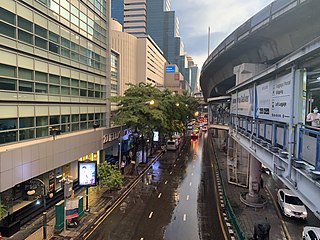
Si Lom Road is a major street in the Thai capital Bangkok, best known for its commercial neighbourhood, which, along with the nearby and roughly parallel Sathon Road, forms one of the city's main business districts. It runs in a southwest–northeast direction between Charoen Krung and Rama IV roads in the city's Bang Rak District, forming the boundary between Suriyawong Subdistrict to its north and Si Lom Subdistrict to its south. Si Lom was one of the earliest modern roads to be built in the city, and some of its side streets serve historic ethnic neighbourhoods from the late nineteenth century, while others are known as shopping and nightlife venues.

Bang Rak is one of the fifty districts (khet) of Bangkok, Thailand. It lies on the eastern bank of the Chao Phraya River, beyond Khlong Phadung Krung Kasem, which marked the old city boundary. Originating from riverside settlements dating from before the city's foundation, Bang Rak grew inland as new roads and canals were constructed through the area during the second half of the nineteenth century and the early twentieth, attracting communities of expatriates and developing into a major commercial district. Bangkok's rapid economic growth in the late twentieth century saw the areas along Si Lom and Sathon roads transformed into one of the city's main business districts, teeming with skyscrapers. The district, officially recognised at least since 1908, covers an area of 5.54 square kilometres (2.14 sq mi), and has a registered population of 48,227. Today, Bang Rak is known for the financial activity of its commercial offices, as well as its vibrant nightlife scenes. Diverse historic and religious sites, most significantly concentrated in Bang Rak Subdistrict on the waterfront, reflect the district's multicultural history.
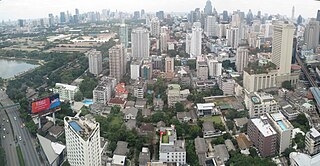
Khlong Toei is a district in central Bangkok, long known for its slum. It is bordered by the Chao Phraya River and contains major port facilities. It is also the site of a major market, the Khlong Toei Market.

Khlong Saen Saep is a canal (khlong) in central Thailand, connecting the Chao Phraya River to Prachinburi Province and Chachoengsao. A portion of the canal is used for public transport by an express boat service in Bangkok. The 72 km long canal passes through 21 districts and is connected to more than 100 smaller canals.

Kowloon Shangri-La is a five-star hotel of the Hong Kong-based Shangri-La Hotels and Resorts group. It is located on Mody Road in Tsim Sha Tsui East overlooking Victoria Harbour and the Hong Kong Island skyline. It is the sister hotel to the Island Shangri-La in Admiralty district, Hong Kong.

Makati Shangri-La, Manila is a hotel located in Makati and one of the three hotels managed by Shangri-La Hotels and Resorts in Metro Manila, Philippines. Opened on April 27, 1993, the hotel had 696 rooms and suites at the time of its temporary closure in 2021; the hotel reopened more than two years later, on August 8, 2023.

The Krungthep Bridge is a bascule bridge (drawbridge) spanning the Chao Phraya river in Bangkok, Thailand. It was the third bridge to be built across the Chao Phraya river. It was constructed by Fuji Car Manufacturing Co., Ltd, with a budget of 31,912,500 baht.

The Rama III Bridge, also known as the New Krungthep Bridge, is a bridge crossing the Chao Phraya River in Bangkok, Thailand. The bridge was completed in 1999 and was designed to alleviate traffic congestion on the adjacent Krungthep Bridge. The bridge was named in honour of King Nangklao.
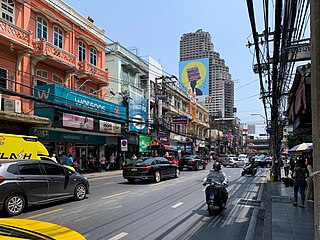
Charoen Krung Road is a major road in Bangkok and the first in Thailand to be built using modern construction methods. Built during 1862–1864 in the reign of King Mongkut, it runs from the old city centre in Rattanakosin Island, passes through Bangkok's Chinatown, continues into Bang Rak district, where it formerly served the community of European expatriates, and ends in Bang Kho Laem. Construction of the road marked a major change in Bangkok's urban development, with the major mode of transport shifting from water to land. Charoen Krung Road was Bangkok's main street up to the early 20th century, but later declined in prominence. It is still home to many historic buildings and neighbourhoods, which are beset by changes as extension of the underground MRT is poised to drive new development.

River City Bangkok, The Anchor of Arts & Antiques (RCB) is the premier hub of art, antiques and cultured lifestyles center in Bangkok, Thailand. It is on the Chao Phraya River on the Si Phraya Pier near many large hotels. It is accessible by car or boat.

Sala Chalermkrung Royal Theatre was originally a movie theatre in Bangkok, Thailand built in Modernist style on Charoengkrung Road. It was opened on 3 July 1933. After serving as a cinema for many years it now hosts performances of classical Thai dance.
Bangkok, the capital of Thailand, is one of the world's top tourist destination cities. Each year, approximately 22.7 million international visitors arrive in Bangkok. MasterCard ranked Bangkok as the world's top destination city, with 15.98 million projected visitors in 2013. It topped the MasterCard Global Destinations Cities Index as the most visited city in the world in 2012, 2013, 2016, 2017 and 2018. The city is ranked fourth in cross-border spending, with 14.3 billion dollars projected for 2013, after New York, London and Paris. Euromonitor International ranked Bangkok sixth in its Top City Destinations Ranking for 2011. Bangkok has also been named "World's Best City" by Travel + Leisure magazine's survey of its readers for four consecutive years since 2010.

Asiatique: The Riverfront is a large open-air mall in Bangkok, Thailand. It occupies the former docks of the East Asiatic Company, and faces the Chao Phraya River and Charoen Krung Road. The complex opened in 2012 after extensive renovation of the site.
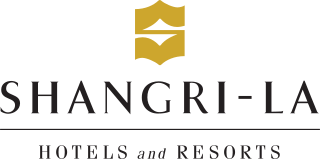
Edsa Shangri-La, Manila is a 5-star luxury hotel located at Ortigas Center, Mandaluyong, Philippines and one of the three hotels managed by Shangri-La Hotels and Resorts located in Metro Manila, Philippines. It opened on August 28, 1992. The hotel has 632 rooms and suites, four international restaurants, two lounges, a cafe, and a bakeshop, across two wings, and is considered a city resort.

Captain Bush Lane, now officially known as Soi Charoen Krung 30, is a side-street branching off Charoen Krung Road in Bang Rak District of Bangkok, Thailand. It was home to several members of Bangkok's early European expatriate community during the turn of the 19th–20th centuries, including Captain John Bush, an influential English sea captain after whom the street is named.
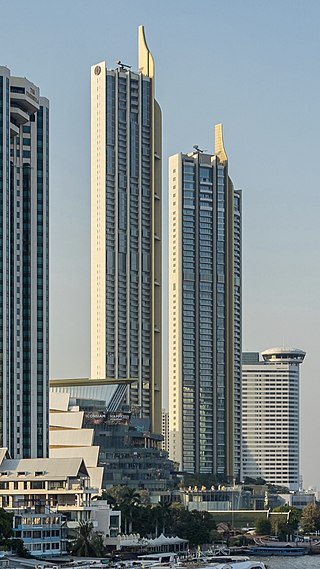
Iconsiam, stylized as ICONSIAM, and ICS is a mixed-use development on the banks of the Chao Phraya River in Bangkok, Thailand. It includes a large shopping mall, which opened to the public on 9 November 2018, as well as hotels and residences. The ฿54 billion project was jointly developed by Siam Piwat group, a Thai retail developer, MQDC Magnolia Quality Development, and Charoen Pokphand Group. The complex includes the tallest building in Thailand: the 70-floor Magnolia Waterfront Residences,and the country’s sixth tallest building: the 52-floor Mandarin Oriental Residences.

Sathorn Pier, with designated pier code/number CEN, is a major pier on the Chao Phraya River located beneath the Taksin Bridge, Sathorn Road in Bangkok, Thailand.

Mahai Sawan Road is a short road and intersection in Bangkok. It runs from Mahai Sawan intersection in Thon Buri District through Bukkhalo intersection and Krungthep Bridge across Chao Phraya River to Phra Nakhon side and ends at Thanon Tok, connecting Charoen Krung Road and Rama III Road in Bang Kho Laem District.

Khlong Maha Sawat, also known as Khlong Chaiyaphruek, is a khlong (canal) in Thailand. It is a man-made waterway dug in 1859–1860 in the reign of King Rama IV. Today it is listed by the Fine Arts Department as a national heritage site. It starts from Khlong Lat Bang Kruai near Wat Chaiyaphrueksamala, flows along the border of Nonthaburi's Bang Kruai with Taling Chan and Thawi Watthana of suburban Bangkok, then flows through Phutthamonthon to meet the Tha Chin River at Ngio Rai Subdistrict in Nakhon Pathom's Nakhon Chai Si District. Its length is 28 km (17 mi). Note: Khlong Maha Sawat and Khlong Prapa Maha Sawat are two different canals.
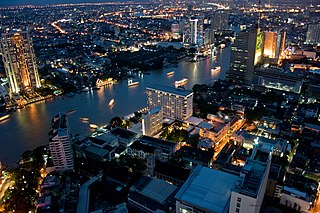
Bang Rak is a khwaeng (subdistrict) and historic neighbourhood in Bangkok's Bang Rak District. It lies between the Chao Phraya River and Charoen Krung Road, and was home to communities of European expatriates who settled in the area mostly during the second half of the 19th century as Siam opened up to the West. Among them were the Portuguese, French and British, whose embassies occupied extensive grounds in the area, Danes who founded shipping companies as well as the historic Oriental Hotel, and Catholic missionaries who established some of the first schools in the country on the grounds surrounding Assumption Cathedral.




















